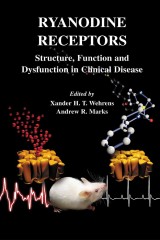Details

Ryanodine Receptors
Structure, function and dysfunction in clinical diseaseDevelopments in Cardiovascular Medicine, Band 254
|
149,79 € |
|
| Verlag: | Springer |
| Format: | |
| Veröffentl.: | 16.01.2006 |
| ISBN/EAN: | 9780387231884 |
| Sprache: | englisch |
| Anzahl Seiten: | 330 |
Dieses eBook enthält ein Wasserzeichen.
Beschreibungen
<P>Drs. Xander Wehrens and Andrew Marks have gathered the collected wisdom of scientists that have devoted their working lives to the study of ryanodine receptors. In this series of brief, but informative, chapters, the contributions progress from the basic gene family and primary structure, through its 3D structure so far, to its regulation and physiology. The book ends with several chapters on mutations in the receptor that causes disease and their role in adaptation to disease. There are interesting new developments in the control of ryanodine receptors by accessory proteins, the latest of which is the proposed role of leaky RyR channels in causing delayed after depolarizations, a cause of lethal ventricular arrhythmias. The series of reviews in Ryanodine Receptors: Structure, Function and Dysfunction in Clinical Disease will bring anyone rapidly up to speed in current progress in the field, as well as highlight remaining questions.</P>
<P></P>
<P>David E. Clapham, MD, PhD<BR>Professor of Neurobiology and Pediatrics<BR>Harvard Medical School</P>
<P></P>
<P>David E. Clapham, MD, PhD<BR>Professor of Neurobiology and Pediatrics<BR>Harvard Medical School</P>
Evolution of the Ryanodine Receptor Gene Family.- Topology and Transmembrane Organization of Ryanodine Receptors.- Three-Dimensional Reconstruction of Ryanodine Receptors.- RYR-DHPR Relationships in Skeletal and Cardiac Muscles.- The Pore of the Ryanodine Receptor Channel.- Intra-Molecular Domain-Domain Interaction.- Regulation of Sarcoplasmic Reticulum Calcium Release by Luminal Calcium.- Cytosolic Calcium Regulation of Single Ryanodine Receptor Channels.- Elementary Ca2+ Release Events: Ryanodine Receptor Ca2+ Sparks.- Ca2+ Release from the Sarcoplasmic Reticulum in Intact Cardiomyocytes.- Stability and Instability of Ca2+ Release from the SR.- Ryanodine Receptors in Smooth Muscle.- Functions of RYR3 Homologues.- Knockout Mice Lacking RYR and Junctophilin Subtypes.- Regulation of Ryanodine Receptor Ca2+ Release by Macromolecular Complexes.- RYR1 Modulation by Calmodulin.- Ryanodine Receptor Function in Inflammation.- Ryanoids, Receptor Affinity and RYR Channel Subconductance.- Scorpion Peptides as High-Affinity Probes of Ryanodine Receptor Function.- Redox Sensing by the Ryanodine Receptors.- Ryanodine Receptor Dysfunction in the Diabetic Heart.- Molecular and Clinical Genetics of RYR1 Disorders.- Pathophysiology of Muscle Disorders Linked to Mutations in the Skeletal Muscle Ryanodine Receptor.- The Dantrolene Binding Site on RYR1.- Ryanodine Receptor Dysfunction in Heart Failure and Arrhythmias.- Stabilization of Ryanodine Receptor as a Novel Therapeutic Strategy Against Heart Failure.- Ryanodine Receptor Antibodies and Myasthenia Gravis.
<P>In recent years, the ryanodine receptor has emerged as a new and very promising target for the treatment of several cardiovascular disorders, including cardiac arrhythmias and heart failure. This volume is the most current publication devoted to the major intracellular calcium-release channel, the ryanodine receptor.</P>
<P></P>
<P>"In this series of brief but informative chapters, the contributions progress from the basic gene family and primary structure, through its 3D structure so far, to its regulation and physiology." </P>
<P></P>
<P>David E. Clapham, MD, PhD<BR>Professor of Neurobiology and Pediatrics<BR>Harvard Medical School</P>
<P></P>
<P>Dr. Xander H.T. Wehrens received his M.D. and Ph.D. degrees from Maastricht University in the Netherlands. His research has mainly concentrated on molecular mechanisms of cardiac arrhythmias, in particular in the setting of inherited arrhythmogenic syndromes and congestive heart failure. This work has led to the development of novel anti-arrhythmic therapies. He is currently a research scientist in the Department of Physiology and Cellular Biophysics at the College of Physicians and Surgeons of Columbia University.</P>
<P></P>
<P>Dr. Andrew R. Marks is the Chair and Professor of the Department of Physiology and Cellular Biophysics at Columbia University College of Physicians and Surgeons. Dr. Marks' research has focused on understanding how macromolecular signaling complexes regulate ion channel function in muscle and non-muscle systems, and on the regulation of vascular smooth muscle proliferation and migration. His work has contributed new understandings of fundamental mechanisms that regulate muscle contraction that have lead to the discovery of molecular defects that contribute to heart failure and fatal cardiac arrhythmias.</P>
<P></P>
<P>"In this series of brief but informative chapters, the contributions progress from the basic gene family and primary structure, through its 3D structure so far, to its regulation and physiology." </P>
<P></P>
<P>David E. Clapham, MD, PhD<BR>Professor of Neurobiology and Pediatrics<BR>Harvard Medical School</P>
<P></P>
<P>Dr. Xander H.T. Wehrens received his M.D. and Ph.D. degrees from Maastricht University in the Netherlands. His research has mainly concentrated on molecular mechanisms of cardiac arrhythmias, in particular in the setting of inherited arrhythmogenic syndromes and congestive heart failure. This work has led to the development of novel anti-arrhythmic therapies. He is currently a research scientist in the Department of Physiology and Cellular Biophysics at the College of Physicians and Surgeons of Columbia University.</P>
<P></P>
<P>Dr. Andrew R. Marks is the Chair and Professor of the Department of Physiology and Cellular Biophysics at Columbia University College of Physicians and Surgeons. Dr. Marks' research has focused on understanding how macromolecular signaling complexes regulate ion channel function in muscle and non-muscle systems, and on the regulation of vascular smooth muscle proliferation and migration. His work has contributed new understandings of fundamental mechanisms that regulate muscle contraction that have lead to the discovery of molecular defects that contribute to heart failure and fatal cardiac arrhythmias.</P>
Most current publication devoted solely to the major intracellular calcium-release channel, the ryanodine receptor Will quickly bring anyone interested in ryanodine receptors up to speed with its brief but informative chapters Drs. Xander Wehrens and Andrew Marks have gathered the collected wisdom of scientists that have devoted their working lives to the study of ryanodine receptors Includes supplementary material: sn.pub/extras
Diese Produkte könnten Sie auch interessieren:

Casos clínicos en endocrinología

von: Victoria Mendoza Zubieta, Alma Vergara López, Alfredo Reza Albarrán, Alfredo Reza Editorial Alfil, S. A. de C. V.

19,99 €

Controversias en geriatría

von: Alberto Francisco Rubio Guerra, María Guadalupe Castro Martínez, María Guadalupe Castro Editorial Alfil, S. A. de C. V.

31,99 €














